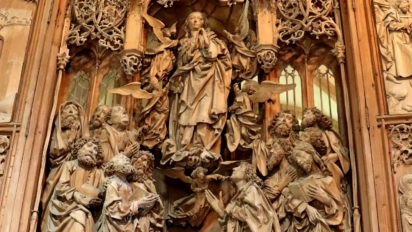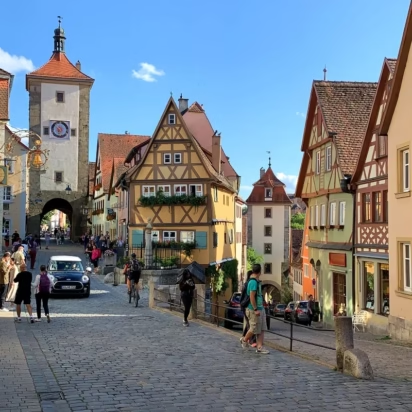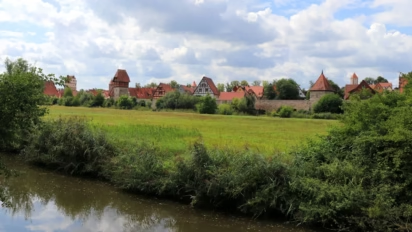The Romantic Road (Romantische Straße) is Germany’s most popular holiday route on the map — it passes through medieval towns including Rothenburg ob der Tauber, Dinkelsbühl, Nördlingen, and Füssen.
The Romantic Road (Romantische Straße) in western Bavaria is the best-known and most popular of Germany’s numerous thematic holiday routes. The top sights include the fantasy neo-Romanesque Schloss Neuschwanstein castle and the wall-enclosed medieval town Rothenburg ob der Tauber. Travelers need not follow the exact map route of the Romantic Road — the sights rather than the scenery are the main attractions. Day-trip bus tours are usually available to Rothenburg from Frankfurt or Munich.
UNESCO-Listed Würzburg Residenz Residence Palace
The Romantic Road starts in Würzburg with its wonderful Residenz palace. This Baroque masterpiece by Balthasar Neumann is one of many German sites on the UNESCO World Cultural Heritage list.
Despite war damage, many churches are worth exploring in the old town. Also visit the Marienberg fortress with the Lower Franconian Museum and several Tilmann Riemenschneider works.
The Romantic Road in the Sweet Tauber Valley (Liebliches Taubertal)
From Würzburg, the Romantic Road briefly passes through the Tauber Valley, which is mostly in the state of Baden-Württemberg. Popular stops in this valley include:
- Bad Mergentheim with a large Teutonic Order castle and a wonderful Rococo church;
- Stuppach with a remarkable Matthias Grünewald painting of the Madonna;
- Weikersheim with a splendid Renaissance palace; and
- Creglingen with its world-famous Tilman Riemenschneider altar and the Fingerhut (Thimble) Museum.
See Top Sights to See in the Liebliches Taubertal for a more detailed description of the Romantic Road sights in the Tauber Valley or Romantic Road Books and Maps at Amazon.
Romantic, Medieval Rothenburg ob der Tauber in Germany
Rothenburg ob der Tauber is the most popular stop on the Romantic Road map and for many travelers the highlight of a visit to Germany. This romantic small town is still completely encircled by a town wall. Rothenburg has managed to maintain its late medieval appearance and is incredibly romantic, especially at night.
Exploring the narrow alleys of medieval Rothenburg and walking along the sentries’ walk on the town walls are free and for many the best part of visiting this medieval town. Rothenburg is hugely popular but most visitors are day-trippers who arrive mid-morning and depart by late afternoon.
Overnight hotel guests may enjoy Rothenburg in the evenings and early mornings in relative tranquility to soak up the very romantic atmosphere. (See Tripadvisor hotel guests‘ recommendations — quality and prices vary.)
Rothenburg ob der Tauber has several formal museums and cultural sights worth seeing too. The Medieval Crime Museum has excellent exhibits of historic torture instruments but is also a very serious presentation of the medieval justice system.
Also worth seeing in Rothenburg is the Holy Blood Altar (Heilig Blut) by Tilman Riemenschneider in the St.-Jakobs-Kirche. The German Christmas Museum and numerous Christmas decoration shops of Käthe Wohlfahrt scattered throughout the old town are also popular sights.
Romantische Straße Route in the Romantic Franconia Region
Fewer visitors visit the romantic sights directly to the south of Rothenburg, allowing those who do to enjoy these sights in relative peace and quiet. Highlights here include:
- Schillingsfürst’s Spanish Baroque palace;
- Feuchtwangen’s 12th-century Romanesque cloisters; and
- Dinkelsbühl’s romantic old town, half-timbered buildings, an interesting church, and an intact town wall.
The Romantic Road in the Ries-Danube Region in Germany
Between Dinkelsbühl and Augsburg are further small towns worth visiting for romantic and historic sights:
- Nördlingen is the only town in Germany where the town wall is still 100% accessible and visitors can actually walk around the town on the sentries’ walk. Nördlingen’s old town is almost perfectly round and sees fewer tourists than Rothenburg or Dinkelsbühl.
- Wallerstein has a huge 65-m (213-ft) rock that can be scaled for lovely views.
- The Romantic Road passes through a tunnel under Schloss Harburg, one of the best-preserved old castles in Bavaria.
- Donauwörth, at the confluence of the Danube and Wörnitz Rivers, has interesting façades along Reichstraße.
Augsburg – The Fugger City on the Romantic Road

Augsburg is by far the largest city on the Romantic Road. Although not a particularly romantic city, it does have some very interesting sights. It was a wealthy city at the end of the Middle Ages and had the first Renaissance buildings in Germany.
The Fuggers, a rich banking and trading family, were based in Augsburg. They left us the Renaissance Fuggerkapelle (Funeral Chapel) and the Fuggerei, the oldest still-in-use social housing complex in the world.
The Augsburger Dom (Augsburg Cathedral) has a Romanesque core and the oldest stained-glass windows in Germany. The Renaissance Rathaus has a very impressive reception hall.
Augsburg has excellent railway connections to Munich and other parts of Germany.
Southern Romantic Road – Heading for the Bavarian Alps

From Augsburg, the Alps are seen on the horizon as the Romantic Road snakes through small towns toward its destiny in the mountains.
- Landsberg on the Lech has a romantic old town with several Baroque façades. Adolf Hitler spent some time in the local jail, which is still in use, following his failed coup d’état in 1923.
- Schongau has a Baroque church by Dominikus Zimmermann but the best sight is in nearby Altenstadt – the Basilica St Martin is arguably the finest Romanesque church in Bavaria.
- Steingaden has an interesting parish church with a Romanesque exterior and Gothic, Renaissance, Baroque, and Rococo elements in its interior.
- The UNESCO World Cultural Heritage-listed Wieskirche is the artistic highlight of the Romantic Road. The Wieskirche, literally Church in the Meadows, is considered the definitive Bavarian Rococo church. Dominikus Zimmermann designed the church and did most of the stucco work, while his equally talented older brother, Johann Baptist Zimmermann, did most of the paintings.
- The Romantic Road ends in Füssen on the Austrian border. This lovely town has a large former monastery and castle but most visitors come to see the Disney-like Schloss Neuschwanstein Castle, Mad King Ludwig’s fantasy castle, and Schloss Hohenschwangau in nearby Schwangau.
Follow the Map of the Romantic Road in Germany
It is possible to drive the full Romantic Road in less than a day but most visitors will spend much more time doing sightseeing. Public transportation on the Romantic Road is not continuous but it is possible to visit most sights without a car.
The Europabus, operated by Deutsche Touring and sometimes referred to as the Romantic Road Coach, frequently changes its route but usually runs a fair part of the Romantische Straße. In 2025, the bus will only run on Sundays from 4 May to 22 September. It will only cover the northern part of the route — Frankfurt am Main to Rothenburg ob der Tauber. Many excursions are available from Frankfurt or Munich to Rothenburg but none cover the full Romantic Road route.
More on Rothenburg ob der Tauber
For more on the Rothenburg ob der Tauber and nearby sights on the Romantic Road:
- Top Sights on the Romantische Straße with Romantic Road Map
- Walk on the Ramparts and Sentry Walk on the Wall of Rothenburg
- Visit the St.-Jakobs-Kirche (St James Church) with the Tilman Riemenschneider Holy Blood Altar
- Visit the Medieval Crime Museum
- Visit the Wolfgang’s Church in the Klingenbastei
- See the Herrgottskirche with Tilman Riemenschneider Altar of the Virgin in nearby Creglingen
- Transportation to Rothenburg ob der Tauber – Driving or Take the Train
- Bus Day-Trip Tours are often available from Frankfurt or Munich.
- Hotel prices in Rothenburg are surprisingly reasonable, except over weekends.
- Save with the Bayern-Ticket on Train Transportation in Bavaria
- Get online quotations for taxis and airport shuttles from Frankfurt or Munich airports.



